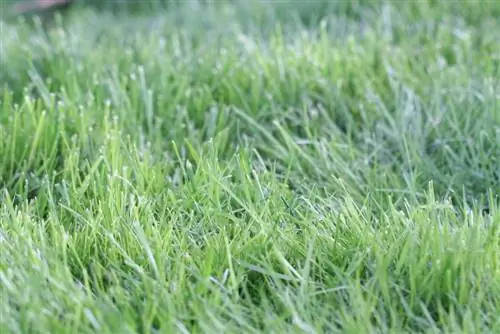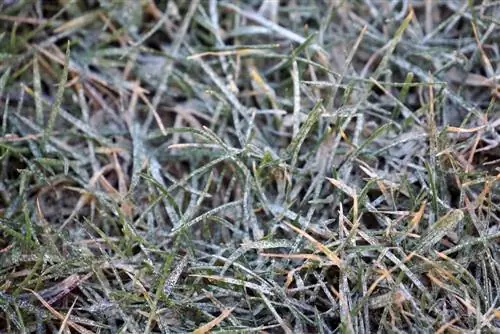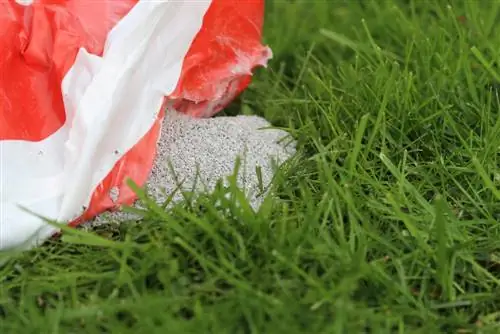- Author admin [email protected].
- Public 2023-12-17 03:39.
- Last modified 2025-06-01 06:48.
If you want to enjoy a he althy lawn in the summer months, you should pay particular attention to the timing and procedure when fertilizing in spring. A lawn is more sensitive than many gardeners think and caring for the lawn is made much easier by fertilizing it correctly. The lawn therefore offers a fresh blanket of grass that looks attractive in the garden.
The best time to fertilize
Lawn needs to be fertilized several times a year, but March is the best time to fertilize in spring. From March onwards, the lawn should be cleaned before fertilization. To do this, branches, remaining leaves and moss are removed from the lawn to allow the grass to absorb oxygen and sun. Cleaning the lawn is still possible during frost. Fertilization itself also takes place from the end of March, when there is no longer any risk of frost.
Pay attention to the weather in your area to determine when frost or snow is not expected. If you want to be on the safe side, you should fertilize towards the end of March or beginning of April, after the first mowing, scarifying and the soil has dried. You should also let the soil rest for some time after sowing. This procedure creates the best conditions for the absorption of fertilizer by the roots.
An alternative - fertilizing in late spring
You can also only fertilize the lawn at the end of May. This is mainly due to the type of grass that is used for lawns in Germany. Since the majority of grasses on German soil have to endure cold winters and warm to hot summers, fertilizing at the beginning of spring can have a counterproductive effect. Since the grasses begin to develop a new root system during spring awakening in order to remain robust in the soil, fertilizing can lead to the grasses burning or weak growth. It is advisable to only fertilize towards the end of May. In the months from March to May, the lawn had enough time to rebuild itself and therefore benefits more from fertilizer. This method is particularly recommended for locations that are particularly cold in winter or for lawns that were fertilized very late in the fall and the active ingredients accumulate in the soil for several months.
Choosing fertilizer
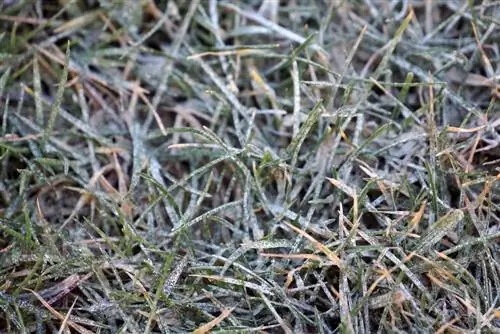
There are different types of fertilizers on the market that are mixed with a variety of mineral substances. In contrast, there are purely organic fertilizers, of which larger quantities are required, but which do not harm the soil or the grass. Four different types of fertilizer can be mentioned here:
- Fertilizer with long-term content
- Starter fertilizer
- Fertilizer with added minerals
- Organic fertilizers
Long-term fertilizer explained
Fertilizers with a long-term content and fertilizers that are mixed with iron or other mineral substances, for example, are among the typical variants that the market has to offer. The long-term fertilizer has an extremely high concentration of ingredients and should be used very sparingly. It is the simplest form of all fertilizers and is marketed as lawn fertilizer. There are also lawn fertilizers for the different seasons, including spring. These enrich the soil with a variety of substances that are intended to promote the growth of grasses. If you don't want to spend a lot of time thinking about a suitable fertilizer, you can choose the slow-release fertilizer, but use it very sparingly.
What is a starter fertilizer?
The starter fertilizer, on the other hand, is a classic spring fertilizer that is effective for lawns that have suffered from extreme weather conditions in the winter. They have high phosphorus content, which quickly disperses into the soil and restores the grasses. The phosphorus allows the grass to form roots more quickly, which also ensures a he althy lawn. These solutions also contain a lot of nitrogen and minerals. In comparison, there are also fertilizers that are designed to address certain mineral and nutrient deficiencies. However, before resorting to such fertilizers, you must be clear about what the problem with the lawn is.
Are organic fertilizers better?
If you don't want to fertilize your lawn with industrially produced or chemical products, you should switch to organic versions. Compost made from plant parts, kitchen scraps and other organic waste is ideal for fertilizing and offers the lawn a gentle alternative to conventional versions. Since plant parts are decomposed into compost by microorganisms, the organic fertilizer has all the necessary nutrients that the lawn needs and does not have excessive concentrations of mineral substances. Advantages of organic fertilizers:
- Works for up to three months
- Creates a robust turf
- Use possible in water protection zones
- Weed infestation low
- Fertility of the soil and lawn is strengthened
- Natural nutrient supply
Fertilize correctly
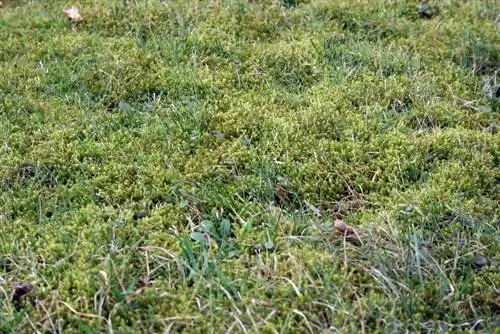
When fertilizing, the most important thing is not to use too much fertilizer, but to cover the entire lawn. With the following instructions you are on the safe side if you want to fertilize your lawn.
- After selecting the appropriate fertilizer, preparing the lawn and sowing new seeds, fertilizing can begin. Water the lawn thoroughly about a week in advance so that the grass does not suffer from a lack of water.
- You can spread the fertilizer either by hand or with a spreader. The spreader is effective for large lawns and also makes your work easier. Since liquid fertilizer is not used for a lawn, this method is always recommended. Tip: Fill the spreader away from the lawn or in a tub. This way you avoid unnecessary loss of fertilizer and collect it quickly if something goes wrong.
- If you use a mineral fertilizer from the hardware store or garden center, you must definitely pay attention to the dosage information. If you prefer to use a little less fertilizer than suggested on the package, you can avoid over-fertilizing.
- Be careful when distributing. Make sure you give yourself enough time to fertilize all areas of the lawn, otherwise bare spots will appear afterwards.
- Fertilize only when there is no threat of heavy rain. The rainwater could wash out the fertilizer and ruin your work.
- Give the lawn enough time to rest after fertilizing. This means you shouldn't mow it for a while to encourage growth. This creates a dense, lively lawn that can develop.
Tip:
After fertilizing, you are welcome to sow more seeds. If the soil temperature remains consistently above 8°C, the seeds close existing gaps in the lawn.
Mulching
If you decide to use an organic fertilizer, mulching allows you to provide the lawn with nutrients for a long time without having to re-fertilize. For mulching, all you need is a lawn mower, which chops the lawn very small compared to other devices. This creates tiny plant residues that remain on the lawn. Together with an organic fertilizer, such as compost, the nutrients work better in the soil and the grass only takes the nutrients it needs. Mulching is a time-saving and cost-effective method, even if you don't have compost. Compost can be purchased at a garden center or hardware store and can easily be used for mulching.
Do not mulch with animal manure
When mulching a lawn, it is not recommended to use animal manure as a substitute for compost. The lawn wouldn't necessarily suffer, but your nose would suffer even more. In addition, there would be an increased infestation of insects and microorganisms, which is counterproductive to a well-kept lawn. Tip: Do not mulch immediately after mowing the lawn for the first time in the spring. Use only the compost as fertilizer and mulch later in the spring.
What to do if you over-fertilize?
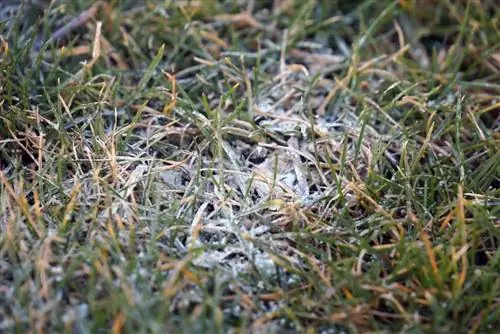
If too much mineral fertilizer has been used, the lawn can suffer from a variety of symptoms, all of which are easily noticeable. Look for the following signs to tell if your lawn is over-fertilized:
- Lawn “burns” (brown spots in the lawn)
- Excessive formation of dandelions
- Excessive formation of sorrel
- Strong moss formation
- Other weeds are increasingly appearing
- Grass looks pale
Depending on the type of fertilizer and the amount used, these symptoms may occur. On the one hand, the lawn is not he althy and is overloaded with substances that it cannot process. In addition, the affected lawns look unsightly or insufficiently maintained, which of course goes against the gardener's aesthetic sense.
What is “burnt” lawn?
Brown, dry stalks are a sign of classic over-fertilization. With these symptoms, the lawn looks as if it has received too much sun because the blades are dry and brown. The lawn looks “burnt” because the grasses cannot handle the amount of fertilizer that was applied. This phenomenon only occurs with chemical or mineral fertilizers, as these pump the soil full of nutrients and can put an extreme strain on individual grass species.
Pale lawn
On the other hand, pale grass is caused by an overdose of lime. The lime moves from the ground into the plant and pale, whitish spots appear on the lawn. Lime is an essential component of many fertilizers, but the use of lime is particularly recommended in sandy or loamy soils. Therefore, in normal soil that is neither too sandy nor too clayey, fertilizers with high concentrations of lime should be avoided.
Moss and weeds
Mosses grow faster when they are supplied with iron. Since iron is a typical component in fertilizers, increased moss formation can often occur. Weeds of all kinds, on the other hand, benefit greatly from nitrogen, which is found in many commercial fertilizers. Before buying fertilizer, look at the amount of nitrogen and iron in the average.
Protect the lawn from over-fertilization
Water is the best way to effectively combat fertilizer. Pay particular attention to your lawn after fertilizing to quickly spot areas that appear to have been over-fertilized. The smaller the over-fertilized area, the better. This makes it easier to flush the fertilizer out of the soil. To do this, take a garden hose and water the affected area over a period of several days. To speed up this process, it is worth scarifying the soil beforehand and watering it afterwards. Scarifying allows the soil to breathe and the increased absorption of oxygen causes the fertilizer to break down more quickly.
What to do in an extensive case of overfertilization?
If the entire lawn is infested or if a very large area is affected so that the use of a single garden hose is not advisable, proceed as follows.
- Mow the lawn to about four centimeters
- scarify
- water (about 15 liters of water per m²)
- check after two weeks
This practice flushes all fertilizer from the soil and prepares the grasses for a strong growing season. However, if this is not the case, the substrate must be replaced. Depending on the infestation, this is the only solution to over-fertilization.



